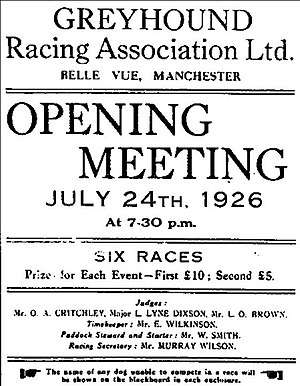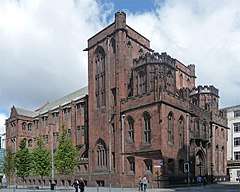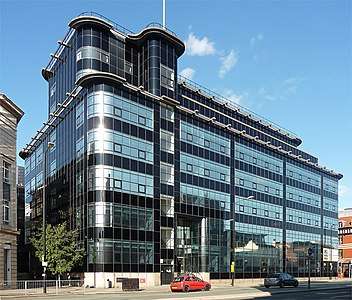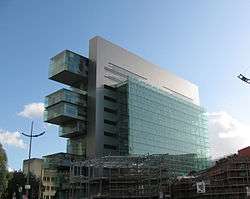Belle Vue Stadium
Belle Vue Stadium is a greyhound racing track in Belle Vue, Manchester, England,[1] where the first race around an oval track in Britain was held on 24 July 1926. It has also been used for motorcycle speedway, as the home ground of Elite League team Belle Vue Aces from 1988 until 2015, and since 1999 stock car racing and banger racing.
The track is operated by the Greyhound Racing Association, who lease it from owners' the Crown Oil Pension Fund. The stadium has luxury glass-fronted grandstands, restaurants, hospitality boxes and bars. Greyhound racing takes place on Saturday evening[2] plus the Bookmakers Afternoon Greyhound Service (BAGS) meetings usually staged on Sunday and Wednesdays.[3]
| Wikimedia Commons has media related to Belle Vue Stadium. |
Greyhound racing
Origins
In 1925, Charles A. Munn, an American businessman, made a deal with Smith and Sawyer for the rights to promote the greyhound racing in Britain. Although the earlier attempt to introduce mechanical racing at Hendon had almost been forgotten, the pastime of coursing was still strong in Britain. The first person Munn contacted was Major L. Lyne Dixson. The Major was a leading figure in British field sports and was quickly won over to the idea presented to him by the American entrepreneur. [4]
Finding other supporters proved to rather difficult however. With the General Strike of 1926 looming, the two men scoured the country in an attempt to find others who would join them. Eventually they met Brigadier-General Alfred Critchley, who in turn introduced them to Sir William Gentle JP. Between them they raised £22,000 and formed the Greyhound Racing Association Ltd. When deciding where to situate their new stadium, Manchester was considered to be the ideal place because of its sporting and gambling links. Close to the city centre, the consortium erected the first custom-built greyhound stadium and called it Belle Vue. The name of the stadium came from the nearby Belle Vue Zoological Gardens that had been built in 1836 and the land on which the stadium was to stand had been an area of farmland known as Higher Catsknowl and Lower Catsknowl. [5]
Opening

The very first race around an oval track in Britain was held on 24 July 1926. More than 1,700 people were attracted to the meeting where they watched a greyhound called Mistley win over 440 yards (402 m). [6]
Six races with seven dogs in each race were held in the first meeting. Fifty years later a stand was named after Mistley, the winner of the first race. Running the quarter-mile flat course in 25 seconds, Mistley romped home eight lengths clear at 6–1. [7]
The first Director of racing was Major-General T Anderson and the first Racing Manager was L.V.Browne. Trainers included Tom Fear, Bill Brinkley & Jack Harvey. After the end of that first meeting, the GRA were horrified to find they had made a loss of £50 but as it turned out they clearly had made a good decision because 16,000 turned up the following week. The first three-month racing season saw more than 11,000 racegoers, 37 meetings and 221 races The consortium repaid a £10,000 bank loan and shares in the new company rose from their initial value of one shilling to £37–10–00 (the equivalent of £37.50 for an outlay of 5p). [8]
Going to the dogs became a national pastime and the GRA became a substantial company.
Pre-War
By June 1927, the stadium was attracting almost 70,000 visitors a week. Belle Vue increased the number of runners per race to seven, but after the formation of the National Greyhound Racing Club (NGRC) in 1928 the maximum number of dogs per race was limited to six. The phenomenal success resulted in an almost instant and dramatic mass build of greyhound stadiums. One early supplier of greyhounds to Belle Vue was Sidney Orton, a Norfolk farmer who sold 17 greyhounds to Belle Vue for £170 in 1927. Orton would eventually turn his attention to training them at Burhill kennels for Wimbledon Stadium. [9]
Belle Vue introduced the Northern Flat as their first major event in 1927. In 1930, as the sport continued as the nation’s leading pastime, the GRA acquired the nearby White City track in the Old Trafford area from Canine Sports Ltd. [10]
It was in 1937 that GRA purchased the land on which the stadium sat bringing the whole operation into their hands. Crowds continued to flock to the race meetings even as war broke out and racing was restricted to daytimes or summer. [11]
Post-War
Mr W S Mulley became Racing Manager in the early fifties and would eventually be replaced by Arthur Aldridge in 1959 who in turn left to be replaced by Norman Russell in the early sixties. The track was chosen by the NGRC to host the BBC Television Trophy four times from 1961 to 1982. [12]
In 1961, the GRA introduced under track heating systems at Belle Vue, Harringay and White City following a successful trial in Scotland. Electric cables were basically sewn into the track by the tractor and a team of workers about eight inches under the turf. They would prove to be useful until the advent of all sand tracks. In 1971 Hall Green Racing Manager Sid Wood moved to Belle Vue and Bob Rowe (son of Leicester Racing Manager John Rowe) filled the position at Hall Green. This was the same year that the GRA experimented with eight dog racing. In fact the Northern Flat took place as an eight dog competition, the first major event to do so. [13]
Following the closure of West Ham in 1972, the classic race known as the Cesarewitch was transferred to sister track Belle Vue and GRA Director of Racing Major Percy Brown retired after 40 years in the sport. It was in the seventies that Belle Vue underwent a £500,000 facelift, the previously mentioned Mistley stand was built and the track was able to offer a state of the art restaurant and tote facilities. The popular side stand was also renamed the Chieftain stand after their Derby champion. [14]
Norman Porter was the Racing Manager at Belle Vue in 1983 when the White City track in Manchester closed its doors. Consequently, the Cock O’the North race was switched to Belle Vue but the Manchester Cup, a former Belle Vue event was scrapped.
Ian Travis became Racing Manager in 1987 and the Cesarewitch was moved to sister track Catford Stadium in 1995 but the Laurels arrived from Wimbledon in 1997.
2000-present day
In 2004, the Gold Collar was hosted by the track following the closure of Catford and a few years later the original classic race the Scurry Gold Cup was brought to the track in an attempt to save the classic race.[15] The Gold Collar and Gorton Cup were discontinued.
In 2014, the National Asset Management Agency (who are the parent company of the GRA) sold Belle Vue Stadium for £2.6 million to Crown Oil Pension Fund,[16] but have it leased back until 2028 at a rent of £249,000 per year.[17] Mutual break options were included in the 15 year tenancy agreement. A similar lease back agreement was agreed in the sale of the Hall Green Stadium with a break clause after five years which was exercised and Hall Green closed in July 2017.[18]
In 2018, the Oaks was given to Towcester following the decision by GRA to reduce their major race schedule.[19] During the same year the stadium signed a deal with ARC to race every Wednesday afternoon and Sunday morning.[20]
Current Competitions
Current greyhound events held at Belle Vue: [21]
- The original classic race the Scurry Gold Cup
Previous Competitions
Previous competitions held at Belle Vue:
- The original classic race the Laurels
- The original classic race the Cesarewitch
- The original classic race the Oaks
- Northern Flat
- Gorton Cup
- Northern 700
- Cock o' the North
- Manchester Cup
- Gold Collar
Track records
| Distance | Greyhound | Time | Date |
|---|---|---|---|
| 260m | Trapstyle Jet | 14.78 | 14.10.2017 |
| 590m | Blakefield Jake | 35.03 | 19.09.2015 |
| 470m | Barnfield On Air | 27.20 | 04.10.2007 |
| 670m | Wordsandatune | 40.15 | 20.08.2009 |
| 878m | Roxholme Girl | 54.33 | 18.03.2006 |
| 470mH | Platinumlancelot | 27.85 | 09.06.2009 |
Achievements
In 1927, Bonzo, handled by Belle Vue trainer Harry Buck, is listed as the first winner of the Grand National known as the Champion Hurdle at the time.[22] In 1930, Belle Vue had an English Greyhound Derby finalist when Dresden trained by Eddie Wright finished fourth to none other than Mick the Miller.[23]
The first major Belle Vue hound was Wild Woolley; the brindle dog had won the Derby with Jack Rimmer in 1932 but switched kennels to join Jimmy Campbell. Belle Vue had 320 heated kennels housing both track's greyhounds and Wild Woolley never looked back winning the Northern Flat in a world record time and the Laurels the following year before returning to Rimmer.
In 1936, Banksell won the Edinburgh Cup for John Dickenson and Genial Radiance claimed the Oaks for A.G.Hiscock. The Northern 700 was set up as a new race in 1937 joining the Northern Flat as prominent events.
In 1957, Cyril Beamount’s Ballypatrick took the Scottish Greyhound Derby title and during June 1964 Belle Vue won the Greyhound Derby for the first time, Hack Up Chieftain trained by Percy Stagg and owned by S.Donohue had won a minor open at Belle Vue when watched by Brigadier General Critchley a GRA Director. Critchley suggested that the greyhound be offered the 48th and last place in that year’s event.
The 1970s started with a bang when Stan Mitchell was named trainer of the year. [24]
The Silver Jubilee year of 1977 was a year to remember because Balliniska Band trained by Eddie Moore claimed a second Greyhound Derby crown for Belle Vue and owner Raphael Bacci.
See Also
Protests
From 2007–2011 weekly protests were held against greyhound racing at Belle Vue by Greyhound Action, an animal rights organisation which campaigned for an end to greyhound racing. [25][26] In addition the Belle Vue Greyhound Action Group also organised and held demonstrations in 2010 to protest at the entertainer Dara Ó Briain's participation in greyhound racing resulting in an article published in the Irish press about O'Briain's greyhound, Snip Nua.[27][28] [29]
In 2008, the Sunday Times revealed that Belle Vue dogs were being sent for research at Liverpool vets school by Charles Thomas Pickering. The Greyhound Board of Great Britain Disciplinary Committee found Pickering in breach of rules 18(i), (ii) and (iii), 152 (i) and (ii), 174(vi) and 174(xiv) (a) and (b) and ordered that he be made a Warned Off person and fined the sum of £5,000.[30]
In 2010, concerns were raised about the injury rates at Belle Vue.[31]Further instances of injury were highlighted in 2014, when a trial session was halted after several dogs sustained serious injuries and one death.[32] Since Greyhound Action disbanded in 2011 the protests have been held by a protest group who call themselves "Shut down Belle Vue".
A 2012 article in the Sunday Express called the kennels of two trainers disgusting. The article alleged that dogs were kept in cramped, dilapidated kennels without heating, and in some cases doors, and that faeces and urine had not been adequately removed. A greyhound protection group, Greytexploitations, provided video footage to substantiate allegations of the poor conditions, these included the image of a Greyhound skull on a dog waste heap.[33] [34]
In July 2014, Caged North West held a remembrance event protest with other greyhound protection groups in Manchester's Piccadilly Gardens, held on the 88th anniversary of the opening of Belle Vue. [35]
Following the independent review of the Greyhound Industry in 2007 by Lord Donoghue, a recommendation was made that the British Greyhound Racing Board and the National Greyhound Racing Club should be disbanded and a new Greyhound Board of Great Britain be created.[36] New Rules and regulations[37] were drawn up and a new welfare rules created[38]
Speedway
A grass-track meeting took place here on 5 May 1928, with Syd Jackson emerging as the winner. The dirt track was stated to be similar in size and shape to Wimbledon and Harringay, with the first meeting going ahead on 28 July 1928, when Frank Arthur won the Golden Helmet.
When the stadium at Hyde Road was sold in 1987, the Aces moved back to the Greyhound Stadium, under the promotion of Peter Collins, John Perrin and Don Bowes. The opening meeting of the new era of the Aces was held on 1 April 1988, and saw Belle Vue take on the Bradford Dukes in the Frank Varey Northern Trophy. However, the match was abandoned after just two heats due to a waterlogged track (rain), with the Aces leading the match.
Due to other commitments, Peter Collins resigned from his promotional position in 1989, leaving Perrin and Bowes in charge of the Aces. With the amalgamation of the two leagues, Belle Vue became members of the British League Division One in 1991.
A further management change in 1994 saw George Carswell link with Perrin and Bowes as co-promoter. Both divisions of the British League joined together to form a 21 team Premier League in 1995, with the Aces becoming founder members.
A further promoting change in 1995 saw John Hall replace Don Bowes, to link up with Perrin and Carswell. The Premier League broke in two at the end of 1996, with the Aces becoming members of the new Elite League, where they have remained up until the present day.
A change of promotion occurred in late 2004 as John Perrin sold the club to Workington promoters Tony Mole and Ian Thomas. This was Thomas's second stint in charge of the Aces. A further change in ownership occurred in December 2006 as ex-captain Chris Morton along with David Gordon and Gordon Pairman bought the club from Tony Mole and Ian Thomas.
Belle Vue departed Kirkmanshulme Lane at the end of the 2015 season, prior to moving to the new National Speedway Stadium for the 2016 campaign.
The shale speedway track was 285 metres (312 yards) in length.
References
- ↑ "Track Search". Greyhound Board of Great Britain. Archived from the original on 25 December 2011. Retrieved 24 December 2011.
- ↑ "Racing Schedule". Love the Dogs. lovethedogs.co.uk. Retrieved 12 January 2018.
- ↑ "Form and Fixtures". Bookmakers Afternoon Greyhound Service. bagsracing.com. Retrieved 12 January 2018.
- ↑ Genders, Roy (1975). The Encyclopedia of Greyhound Racing, page 61. Page Bros (Norwich) Ltd. ISBN 0-85020-0474.
- ↑ Genders, Roy (1975). The Encyclopedia of Greyhound Racing, page 61. Page Bros (Norwich) Ltd. ISBN 0-85020-0474.
- ↑ Genders, Roy (1981). The Encyclopedia of Greyhound Racing, page 34. Pelham Books Ltd. ISBN 07207-1106-1.
- ↑ Genders, Roy (1981). The Encyclopedia of Greyhound Racing, page 34. Pelham Books Ltd. ISBN 07207-1106-1.
- ↑ Genders, Roy (1990). NGRC book of Greyhound Racing, pages 44-45. Pelham Books Ltd. ISBN 0-7207-1804-X.
- ↑ Genders, Roy (1981). The Encyclopedia of Greyhound Racing, page 35. Pelham Books Ltd. ISBN 07207-1106-1.
- ↑ Genders, Roy (1981). The Encyclopedia of Greyhound Racing, page 35. Pelham Books Ltd. ISBN 07207-1106-1.
- ↑ Genders, Roy (1981). The Encyclopedia of Greyhound Racing, page 35. Pelham Books Ltd. ISBN 07207-1106-1.
- ↑ Genders, Roy (1990). NGRC book of Greyhound Racing, pages 45-46. Pelham Books Ltd. ISBN 0-7207-1804-X.
- ↑ Genders, Roy (1990). NGRC book of Greyhound Racing, pages 45-46. Pelham Books Ltd. ISBN 0-7207-1804-X.
- ↑ Genders, Roy (1990). NGRC book of Greyhound Racing, pages 45-46. Pelham Books Ltd. ISBN 0-7207-1804-X.
- ↑ Hobbs, Jonathan (2007). Greyhound Annual 2008, page 182. Raceform. ISBN 978-1-905153-53-4.
- ↑ "CBRE advises on Stadia Sale". Headline Communications.
- ↑ Paul, Norman. "Greyhound Racing Association sells Brum and Manchester stadiums". costar.co.uk. CoStar Group. Retrieved 12 January 2018.
- ↑ Tamlyn, Jones. "Hall Green Stadium to close as 90th birthday looms". birminghammail.co.uk. Birmingham Mail. Retrieved 12 January 2018.
- ↑ "Towcester gets the Oaks, Leger Stays at the Barr". Greyhound Star.
- ↑ "Arc Schedule Released". Greyhound Star.
- ↑ "Open Race Categories". Greyhound Board of Great Britain.
- ↑ Barnes, Julia (1988). Daily Mirror Greyhound Fact File. Ringpress Books. ISBN 0-948955-15-5.
- ↑ Dick, Barrie (1990). Greyhound Derby, the first 60 years. Ringpress Books. ISBN 0-948955-36-8.
- ↑ Barnes, Julia (1991). Daily Mirror Greyhound Fact File. Ringpress Books. ISBN 0-948955-61-9.
- ↑ ""Week of Slaughter" at Manchester dog track". Independent Media Center. Retrieved 7 January 2015.
- ↑ "Yet another greyhound killed at Belle Vue". Independent Media Center. Retrieved 7 January 2015.
- ↑ "Greyhound death demo greets Dara". Independent Media Center. Independent Media Center. Retrieved 5 January 2015.
- ↑ Swords, Warren (31 January 2010). "IT'S A DOG'S , LIFE DARA; Activists Target Comic after His Greyhound Dies". highbeam.com. Retrieved 7 January 2015.
- ↑ "Dara's Dog Starred in Three Men after She Was Put Down; Comedian Too Upset to Talk about Death of His Greyhound Snip Nua". highbeam.com. Retrieved 7 January 2015.
- ↑ "Greyhound breeder offers slow dogs to be killed for research". Retrieved 5 January 2015. (subscription required)
- ↑ Qureshi, Yakub (28 April 2010). "30 injured greyhounds put down at dog track". Manchester Evening News. Retrieved 5 January 2015.
- ↑ "August carnage at Belle Vue Greyhounds". Independent Media Center. Retrieved 5 January 2015.
- ↑ "The secret slaves of the dog racing industry". greytexploitations.com. 2 February 2012. Retrieved 7 January 2015.
- ↑ Jeory, Ted (22 January 2012). "Dog kennels branded 'disgusting'". Sunday Express. Retrieved 7 January 2015.
- ↑ "Greyhound Remembrance 2014". CAGED. NW. Retrieved 7 January 2015.
- ↑ "Independent Review of the Greyhound Industry". Donoghue Report.
- ↑ "Rules and Regulations". GBGB.
- ↑ "Welfare". GBGB.




